View From Sapsucker Woods: Pushed to the Top by Climate Change
By John W. Fitzpatrick
From the Spring 2014 issue of Living Bird magazine.
April 15, 2014
Related Stories
One of the biggest challenges posed by climate change is that it is so difficult to see. Because many of its effects are long-term and hard for humans to perceive, our tendency can be to “wish it away.” Short-term episodes such as sizzling heat spells and super-storms (e.g., Hurricane Sandy) capture the news and generate conversation about climate change, but these events fall under the category of weather, not climate. The former refers to day-to-day variations in temperature, precipitation, wind, and air pressure, while the latter describes long-term averages of weather variables, and their enduring influences on physical and biological environments.
Telltale signs of climate change do exist, and some are dramatic, such as the stunning then-and-now photographs of the world’s great glaciers. Of the 150 glaciers identified and photographed a century ago in Montana’s Glacier National Park, for example, only 25 exist today and researchers predict that most of these will be gone by 2030. Glaciers are receding all over the world, and no reputable scientist disputes that this is being caused by climate change. Two remarkable new studies by young scientists at the Cornell Lab have shed dramatic new light on an important (and alarming) biological effect of climate change.
Cornell grad student Ben Freeman and his wife, Alexa Class Freeman, spent a physically demanding year in New Guinea replicating Jared Diamond’s famous lowland-to-mountaintop surveys of bird distributions on Mt. Karimui in 1965 and the offshore island of Karkar in 1969 (see ScienceScope, page 12). Using mist nets, playbacks, point counts, and excellent birding skills, Ben and Alexa carefully documented the minimum and maximum elevations for all bird species detected on both mountains. Back at the Lab, they compared their data with Diamond’s, and the results are astonishing: bird communities are rapidly shifting their distributions upslope, just as predicted by climate change models. To quote from their Abstract, “upslope shifts averaged 113 m (Mt. Karimui) and 152 m (Karkar Island) for upper limits and 95 m (Mt. Karimui) and 123 m (Karkar Island) for lower limits.” Moreover, by assembling all the evidence they could find from comparable re-survey studies around the world, they conclude that tropical species are shifting upslope faster and more dramatically than are temperate zone species. From a conservation standpoint, this is a major discovery because tropical mountain ranges host some of the world’s most diverse and locally endemic communities. Hundreds of species restricted to the mountaintops are now at risk of being squeezed out of existence.
Postdoctoral fellow Scott Taylor, plus colleagues at the Lab and at Villanova University, used modern genomic techniques and eBird data to reveal that a narrow hybrid zone between Carolina and Black-capped chickadees in Pennsylvania has shifted northward 11.5 km in just one decade. The startling revelation is that this northward movement exactly tracks the northward shift in average wintertime low temperatures presumably caused by climate change. This range shift is so rapid that the research team studying this highly informative hybrid zone has been forced to add new sampling points farther north to keep ahead of the shift.
Both of these studies reveal that birds are acting just like glaciers, receding northward and upward along mountain slopes in response to warmer average temperatures. Both studies also reveal for the first time how fast these changes are occurring. It took Ben and Alexa an exhausting year in the jungle to snap their then-and-now pictures, and it took Scott and his colleagues a huge research team, a modern genomics lab, and thousands of volunteer birders to snap theirs. But just like the glacier pictures, these remarkable studies draw attention to measurable and dramatic biological effects of a changing atmosphere. Studies like these literally bring climate change to life, right before our eyes. No more wishing it away.
References
Freeman, B. and A.M. Class Freeman. 2014. Rapid upslope shifts in New Guinean birds illustrate strong distributional responses of tropical montane species to global warming. PNAS. doi:10.1073/pnas.1318190111
Taylor, S. A., T. A. White, W. M. Hochachka, V. Ferretti, R. L. Curry, and I. Lovette. 2014. Climate-mediated movement of an avian hybrid zone. Current Biology. doi.org/10.1016/j.cub.2014.01.069

All About Birds
is a free resource
Available for everyone,
funded by donors like you
American Kestrel by Blair Dudeck / Macaulay Library






